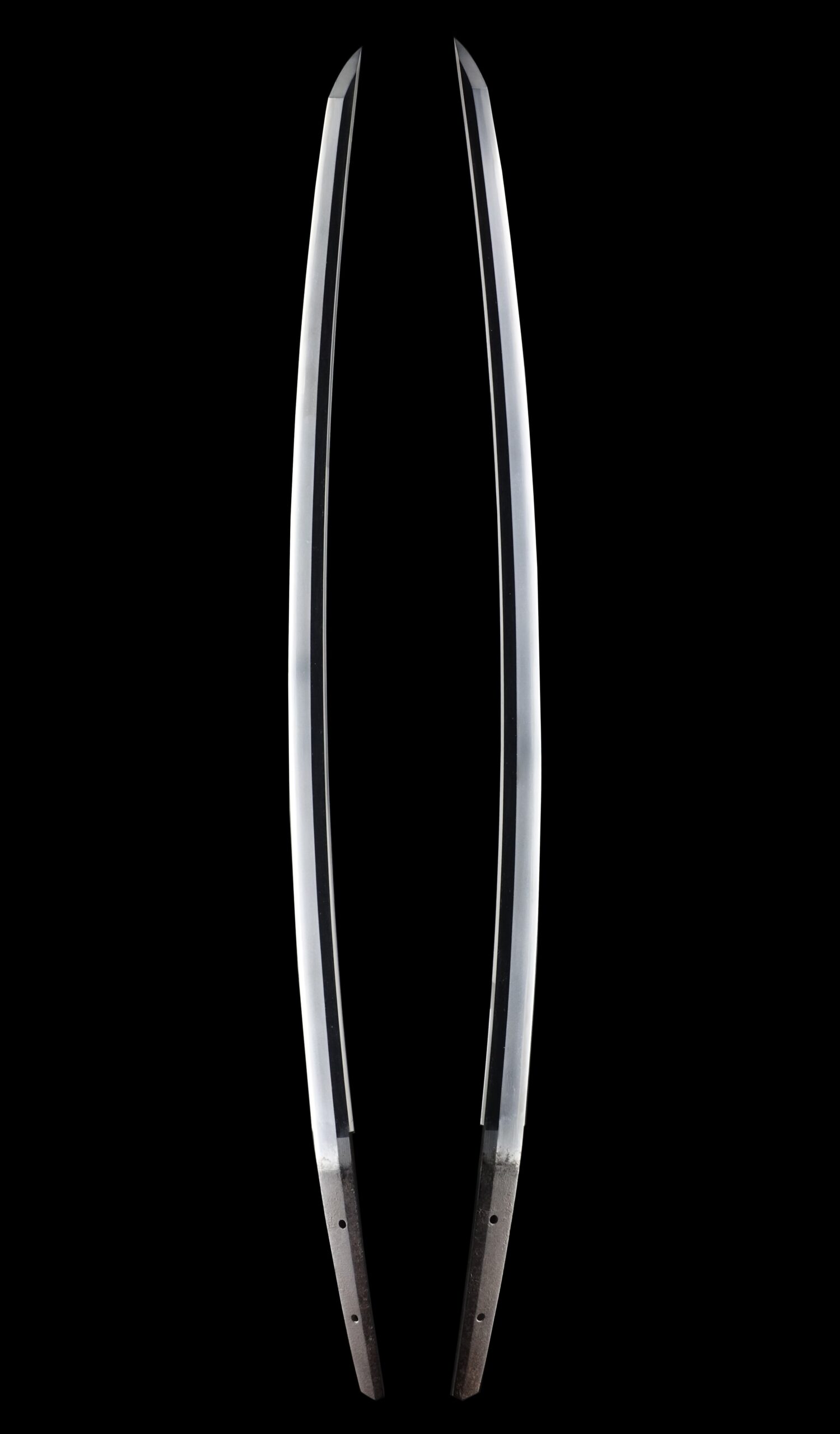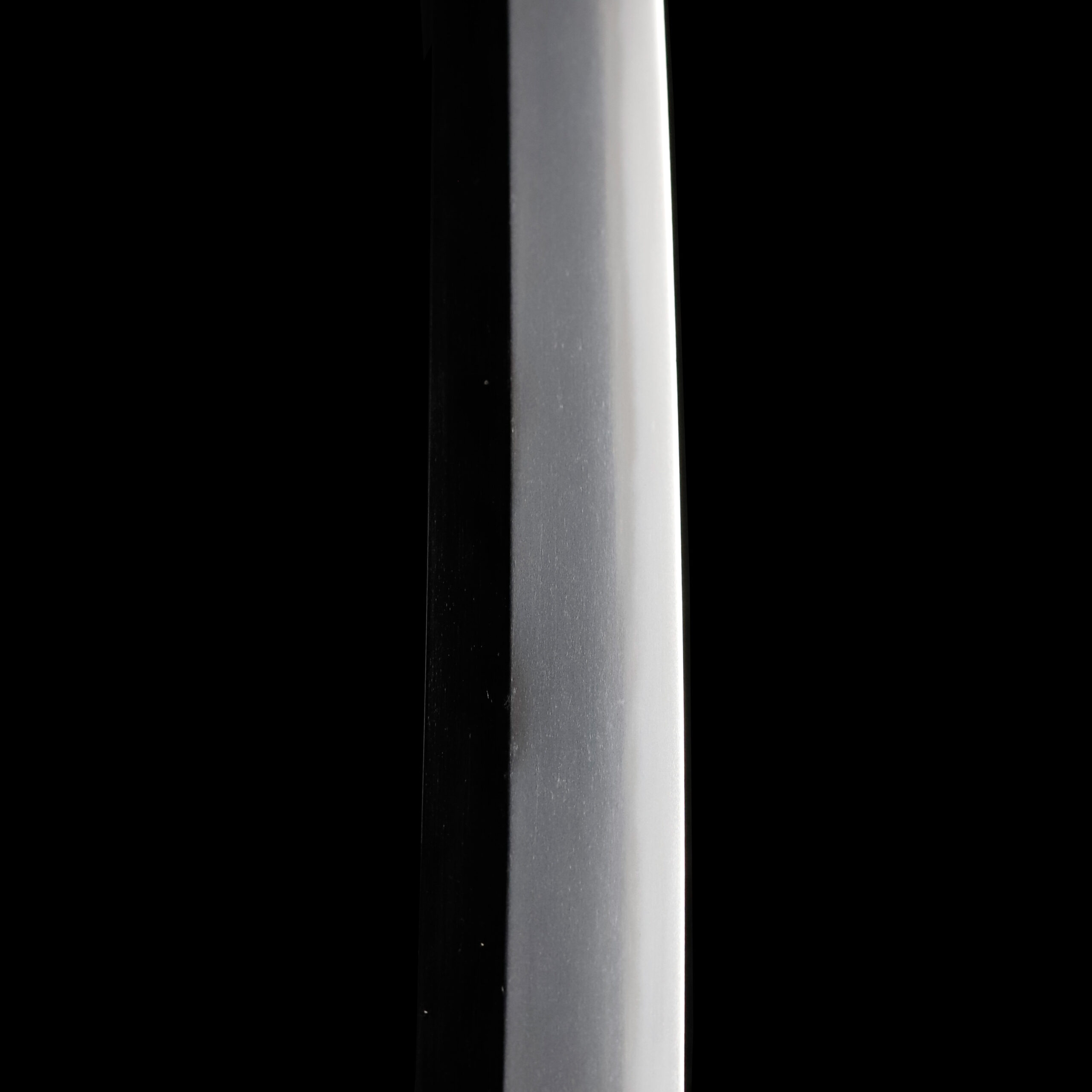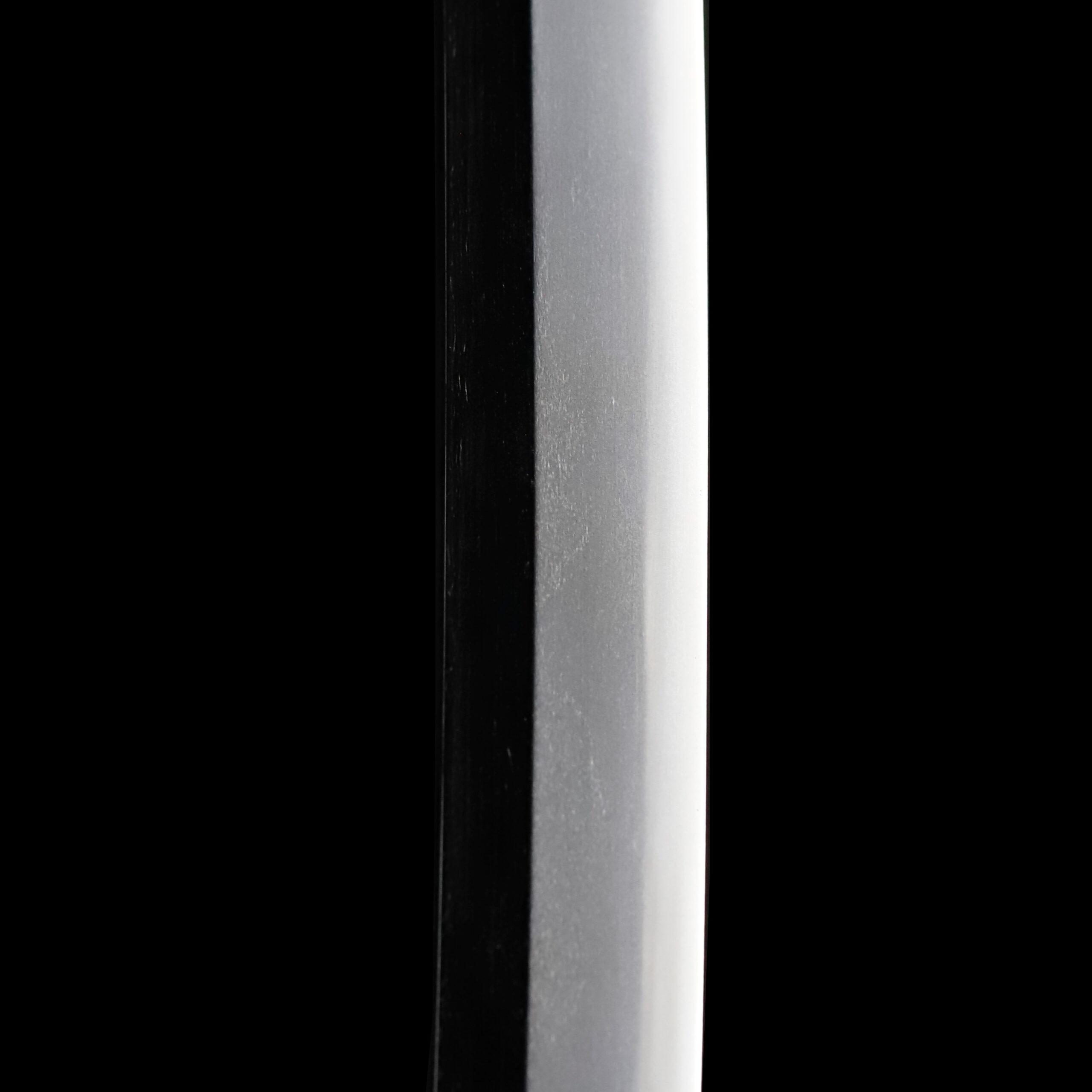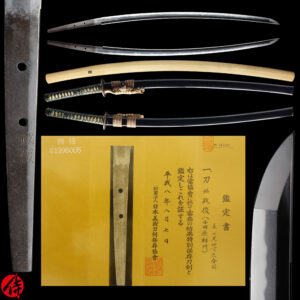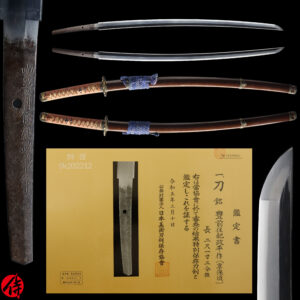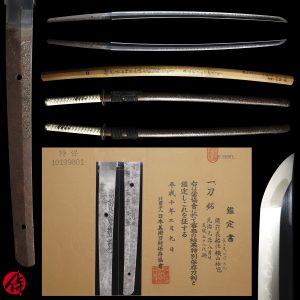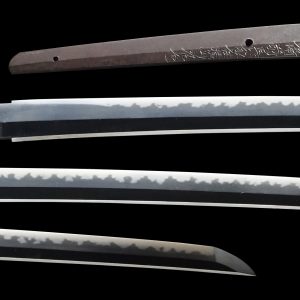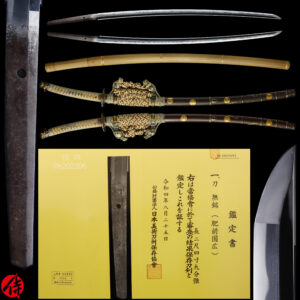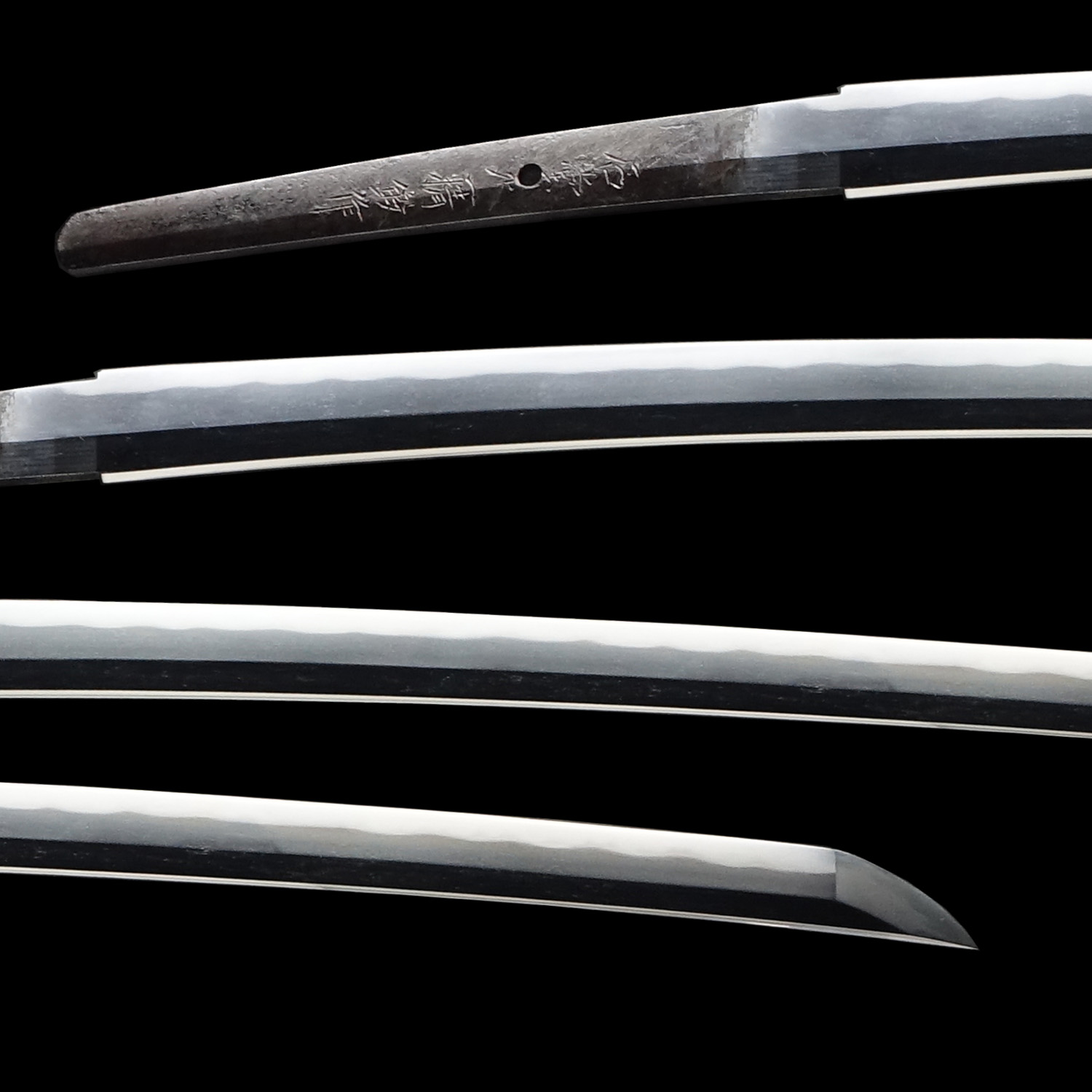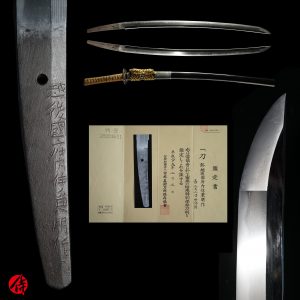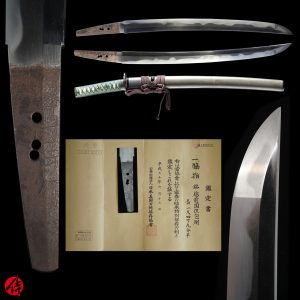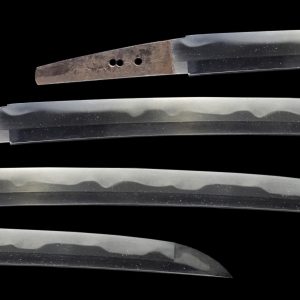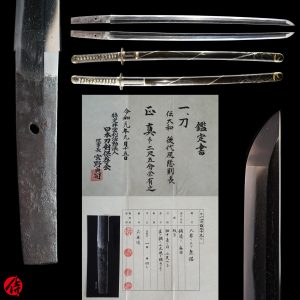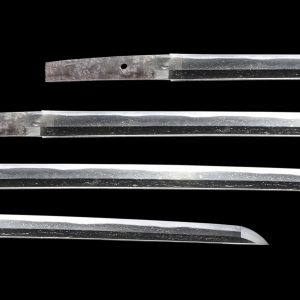Antique Japanese Sword Tachi attributed to Ryumon with Tokubetsu Hozon Certificate
【Description】
Summary
This blade is attributed to Ryumon (龍門), which was one of the prestigious schools in Yamato region (Today’s Nara prefecture), active during the late Kamakura period (approx. 700 years old). It is said that Ryumon was a branch of Senjuin school that served Toudaiji temple. Senjuin school is the oldest school that flourished during the Kamakura-Muromachi period in the Yamato region. The swordsmiths who were members of Ryumon school resided in Ryumon village in Nara prefecture. The most prominent figure that belonged to this school is Ryumon Nobuyoshi.
Senjuin School in Yamato region
There was a temple called Senjudo in Nara prefecture where Senju Kannon (Thousand Arms) Budha statue was worshiped. And a group of swordsmiths who lived there was known as Senjuin (千手院). They belonged to Todaji temple. Senjuin School was founded by Yukinobu, who was the son of Yoshiyuki, another famous swordsmith. Yukinonobu was originally a servant for Senjuin temple, a branch of Todaiji temple during the late Heian period (1086-1107), and eventually became a swordsmith who exclusively forged blades for Todaiji temple.
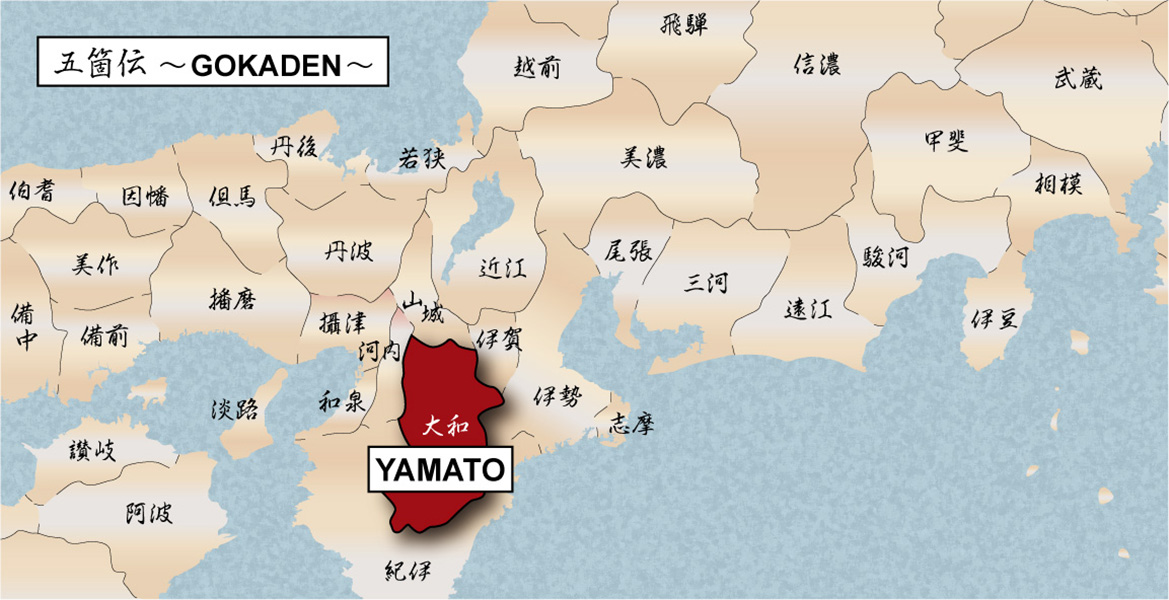
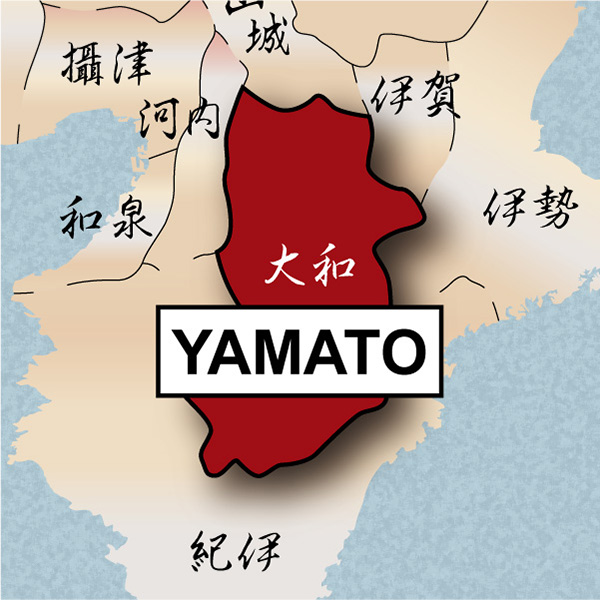
Yamato Region
There were five prestigious schools, including Senjuin school, during the Kamakura-early Muromachi period in Yamato province. They are called Yamato Goha(大和五派); Senjuin(千手院), Shikkake (尻懸), Taima(当麻), Hosho(保昌) and Tegai(手掻) school. They served politically powerful monks and temples in Nara, such as Todaiji temples.
They were initially forging swords for military monks who became powerful due to the government’s policy back then. Monks needed many weapons as there were many political rivalries between influential temples. They required strong weapons like swords to protect themselves. During this time, Senjuin school or other Yamato sword schools met the requests from monks. They also forged blades for Samurai during their heyday.
The swords forged in Yamato regions are famous for their beautiful Jigane, steel surface, and straight tempering line(Suguha). This blade has a beautiful Jigane with a Suguha tempering line, which shows an outstanding characteristic of the Yamato sword.
Tachi Koshirae
This blade was categorized as a Tachi blade. It is also stored in Tachi(太刀) Koshirae. Tachi was mainly used by an armored Samurai with one hand on horseback from the Heian period (794-1185 A.D.) until the early Muromachi period. TACHI was suspended loosely on the left waist with its edge facing the ground so that you could draw it faster to cut down soldiers on the ground. Because of its gorgeous looking, having a Tachi-style sword mounting became a social status among Samurai.
It is appraised as a Tokubetsu Hozon Token(特別保存刀剣) issued by NBTHK(Nihon Bijutsu Touken Hozon Kyokai:日本美術刀剣保存協会). This authentication paper was only given to authentic Japanese swords, especially well preserved and high quality with artistic value.
【 Blade】
Cutting Edge Length(Nagasa): 69.9 cm (27.5 inches)
Curvature(Sori):2.1 cm (0.83 inches)

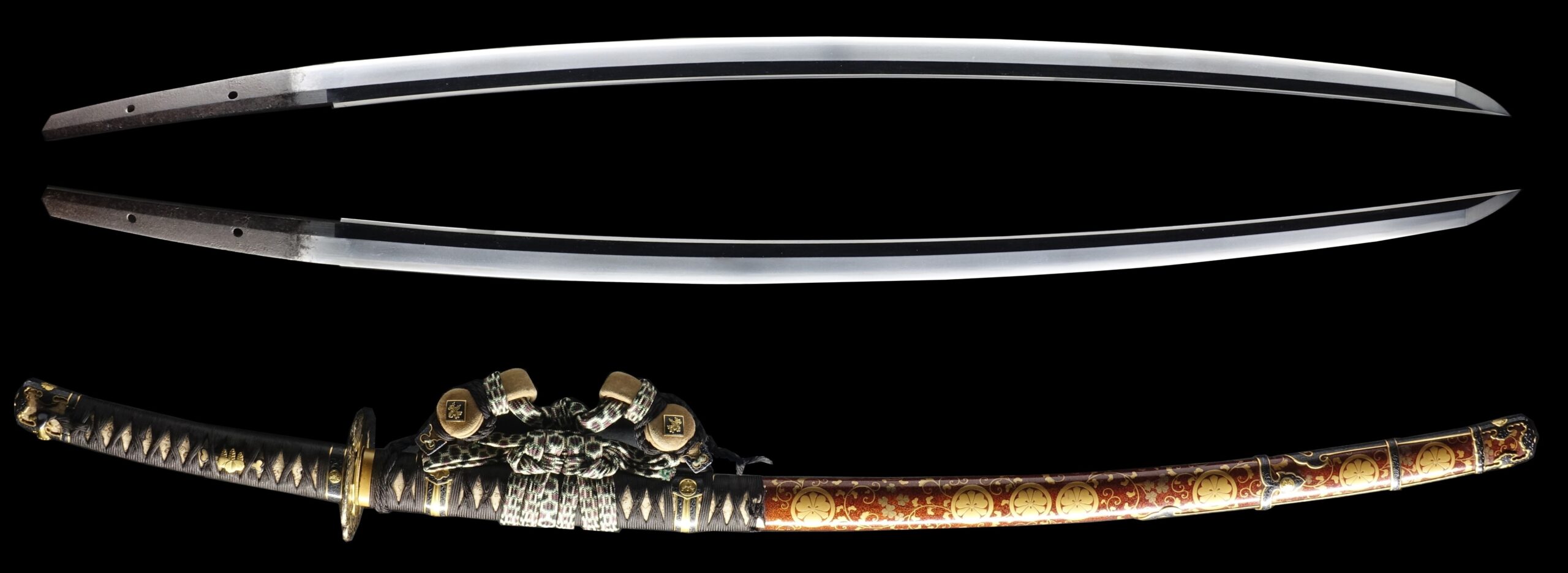
Hamon:
The crystalline structure which forms along the cutting edge of a blade as a result of the hardening process
Jimon(Jihada):
visible steel surface pattern created by folding and hammering during forging process
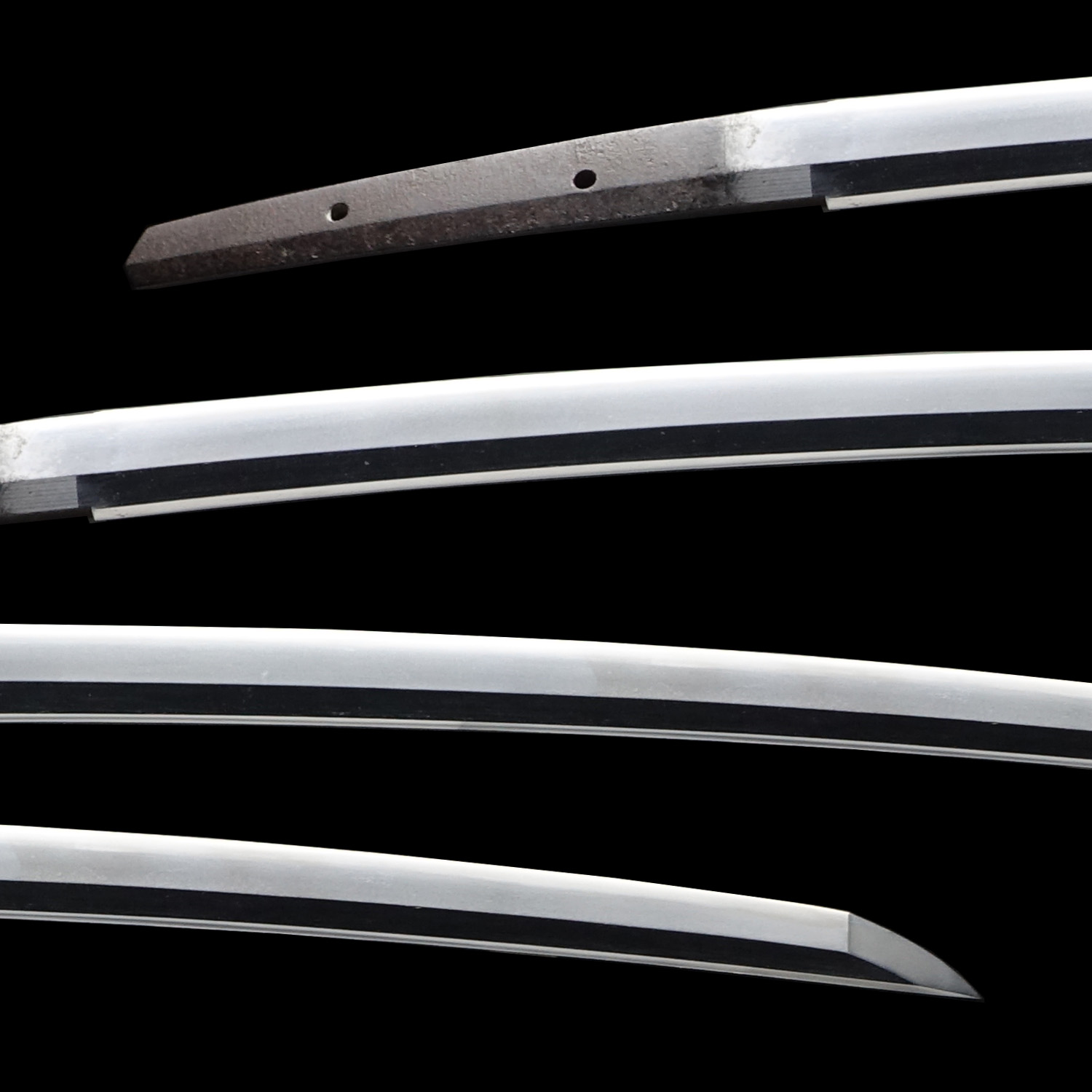
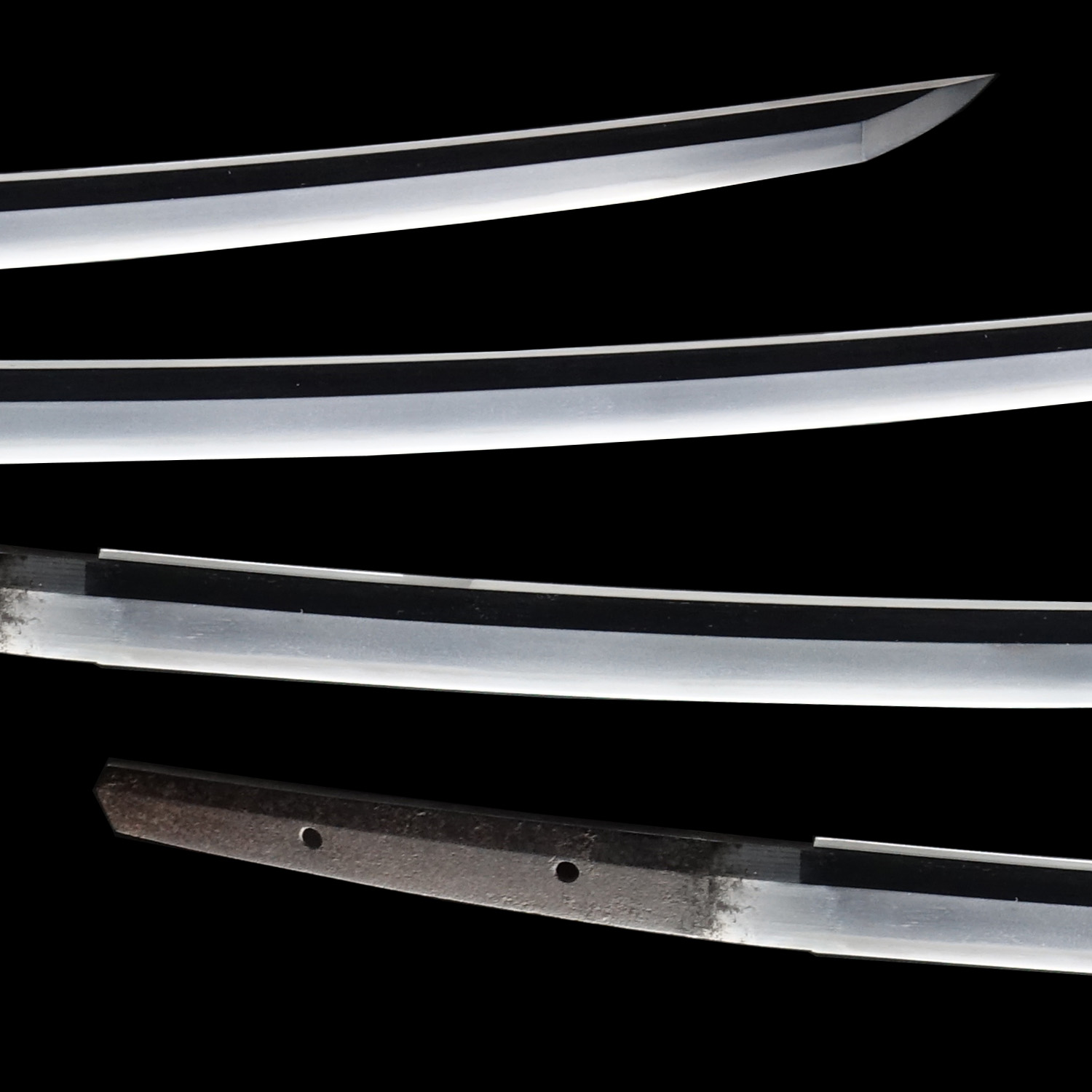
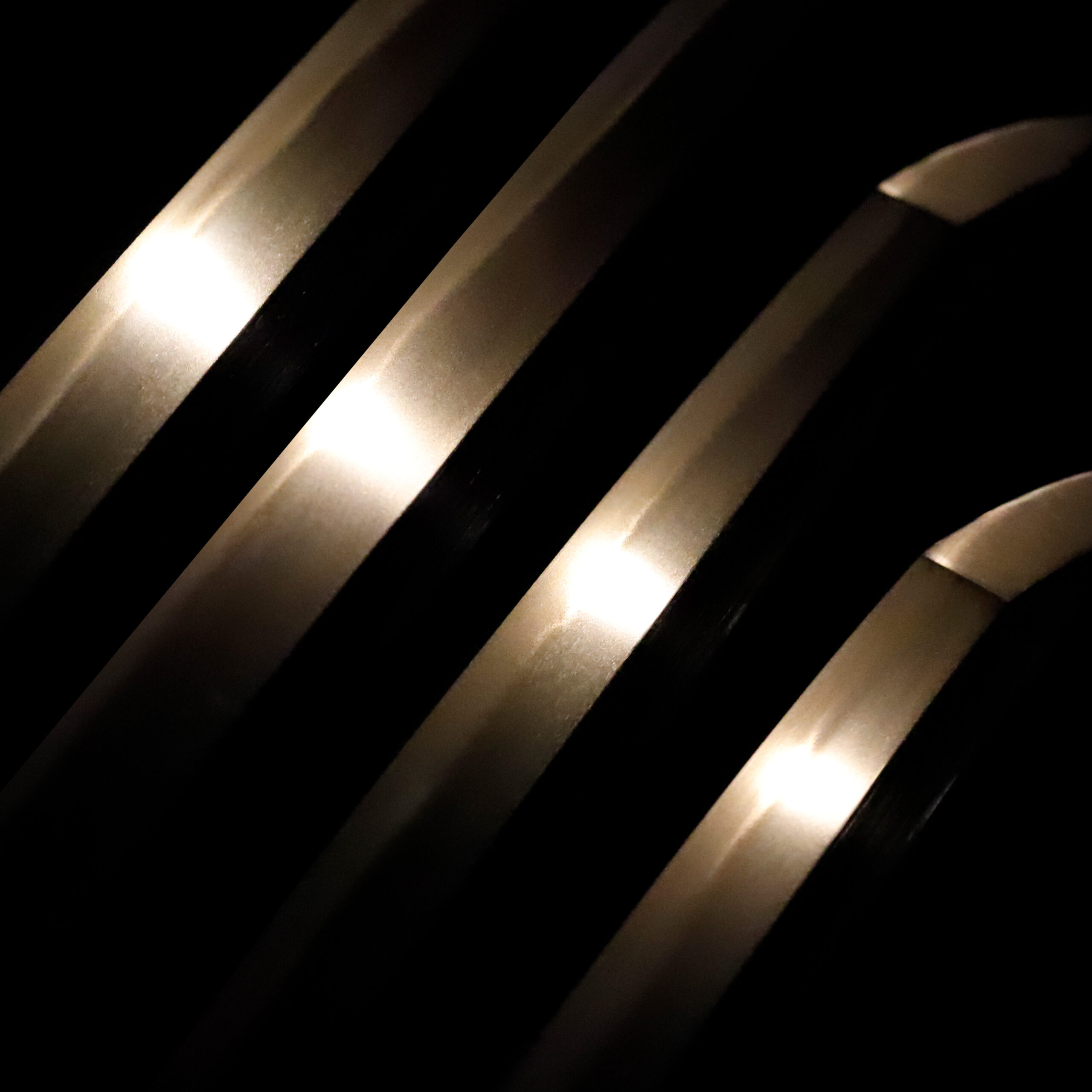

Nakago:Nakago is the tang of the Japanese sword.
Japanese swordsmiths left the black rust on the tang because it prevents red rust while the tang is in its handle. And the discoloration of the tang was created over time, and it is a great indicator for a Japanese sword specialist to estimate when the sword was forged.

Koshirae: Koshirae is the mounting of the Japanese sword. There are several parts that consist of Koshirae such as Saya(Scabbard), Tsuka(Handle), Tsuba(Handguard).

Fuchi-Kashira:A pair of matching sword fittings that cover the upper and bottom parts of its sword hilt.
In the Tachi Koshirae (太刀拵), these sword mountings are called the Kabutogane (冑金/兜金) and the Fuchi Kanamono (縁金物). The Kabutogane is a metal fitting attached to a handle’s end. It corresponds to the Kashira (頭) part of the Fuchi Kashira (縁頭). It seems the Karakusa (唐草, arabesque) pattern decorates it. About this design, we explain in the following description of the Tsuba.
And the Fuchi Kanamono (縁金物) is also a metal fitting attached to the handle but on the opposite side of the Kabutogane. It corresponds to the Fuchi (縁) part of the Fuchi Kashira. There are designs of flowers and leaves on it.
In addition, a Sarute/Sarude (猿手) is attached to this Kabutogane. The user of a sword passed the Udenukio (腕貫緒, a cord wrapped around the wrist to prevent a sword from falling out of the hand, mainly used when riding a horse) through this ring.
This Fuchi Kashira has an elegant look. The same family crest is designed on each Fuchi part and Kashira part. And the Karakusa (唐草, arabesque) pattern surrounds the crests. The family crest designed on this Fuchi Kashira is a kind of Ken Katabami (剣片喰) design called the Sumiiri Kakuni Ken Katabami (隅入り角に剣片喰). The Katabami (片喰) is a plant whose leaf has a heart mark shape. People thought this plant design represented the prosperity of descendants; therefore, many Samurai cherished this pattern. In addition, this plant was favored for its strong vitality that did not wither even when trampled as a weed. The Ken Katabami is a combination of swords and Katabami leaves. It is said that people have associated with the Samurai by incorporating the sword motif. Understandably, lots of Samurai families used the Ken Katabami pattern. It shows the relationship between this plant motif and the Samurai culture.
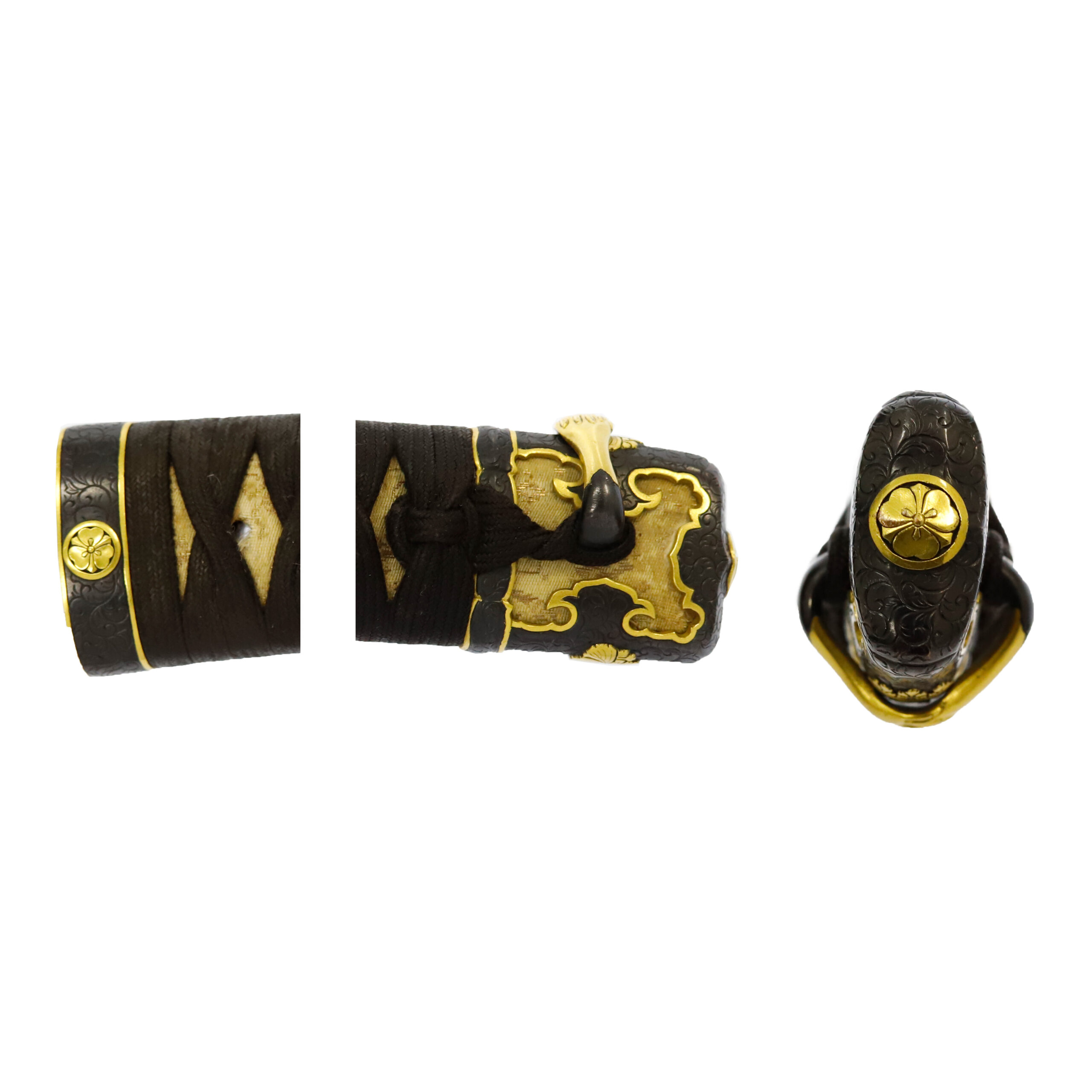
Tsuka and Menuki:Tsuka is the handle of the Japanese sword and Menuki is its decoration.
The Goshichi-no Kiri (五七の桐) pattern is the motif of this Menuki. It is a kind of the Kiri (桐, paulownia) pattern and is generally composed of three standing straight inflorescences and three leaves. The number of blooming flowers at each inflorescence means the ranks of this design. The Gosan-no-Kiri Monyou (五三の桐) pattern is a popular design that the paulownia motif is used. This design was once used by the imperial family and people in authority at that time. Today, it is permitted to use by ordinary households and is appreciated as their family crests. According to a tradition, the Houou (鳳凰, Fenghuang, a kind of sacred beast) rests its wings at the paulownia tree; therefore, it has come to be regarded as a holy plant.
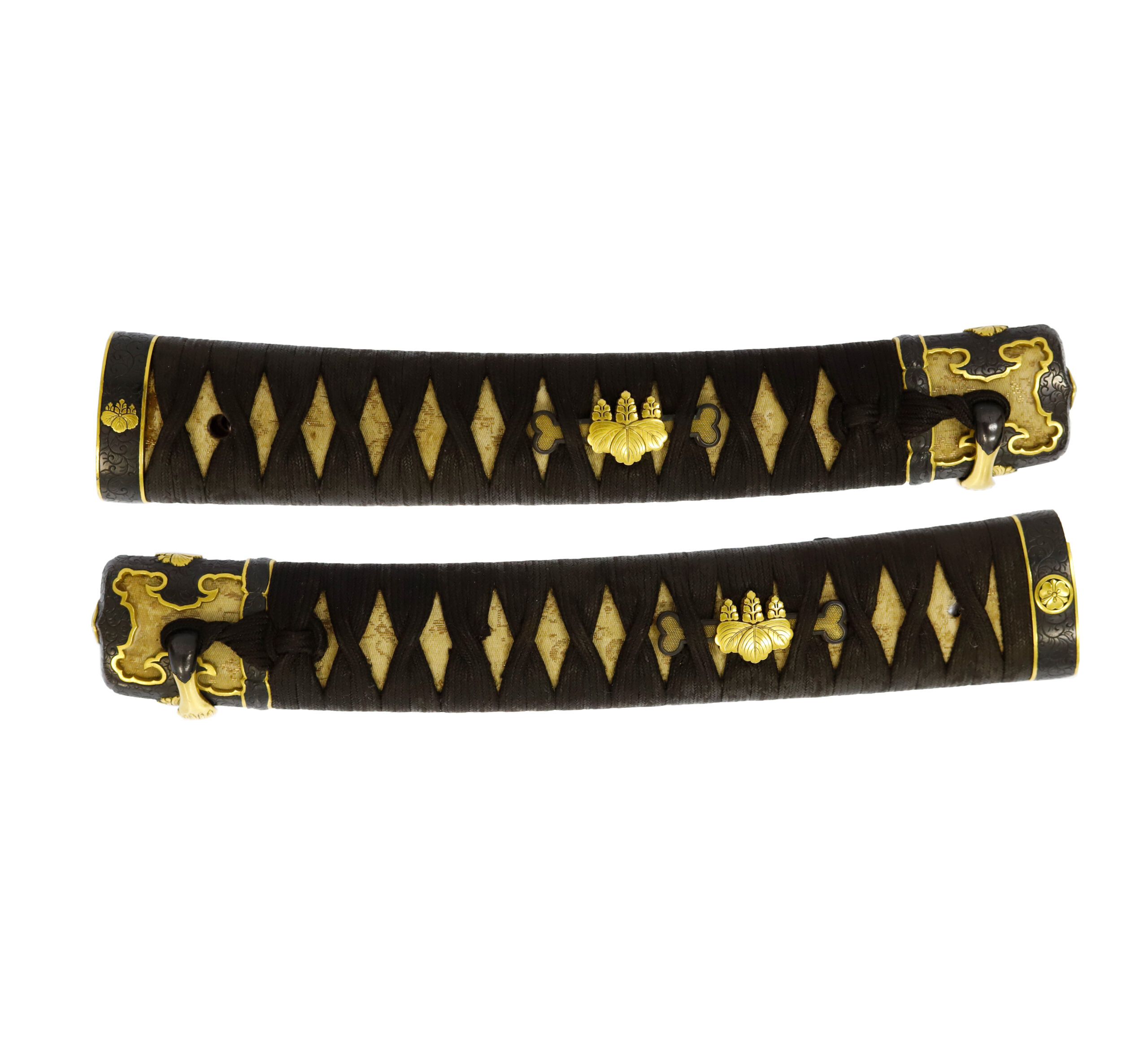
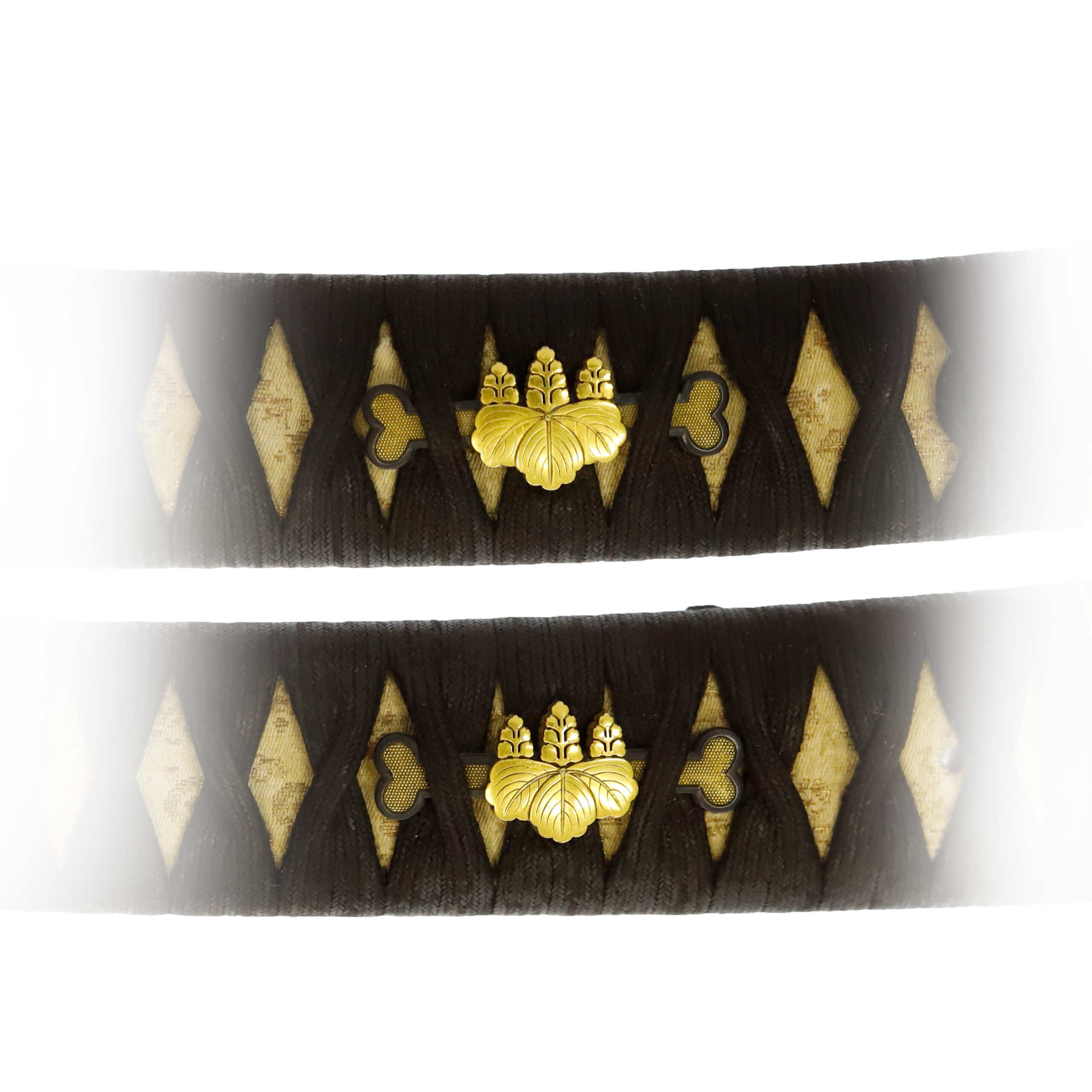
Tsuba and Habaki:Tsuba is the handguard for the Japanese Sword and Habaki is the equipment to make the blade not touch its scabbard inside. It prevents the blade from getting rusty and chipped.
Same as the Menuki, the Goshichi-no Kiri pattern is designed on this Tsuba. The paulownia crest and Karakusa pattern are drawn so as to fill the entire tsuba, giving it a luxurious appearance. The Karakusa design is a pattern in which vine stems, and leaves are twined and make curves. Since ivy has a strong vitality and grows up without interruption, people regarded this design as a symbol of prosperity and longevity. This plat pattern is often seen in sword mountings and adds decorativeness to works.
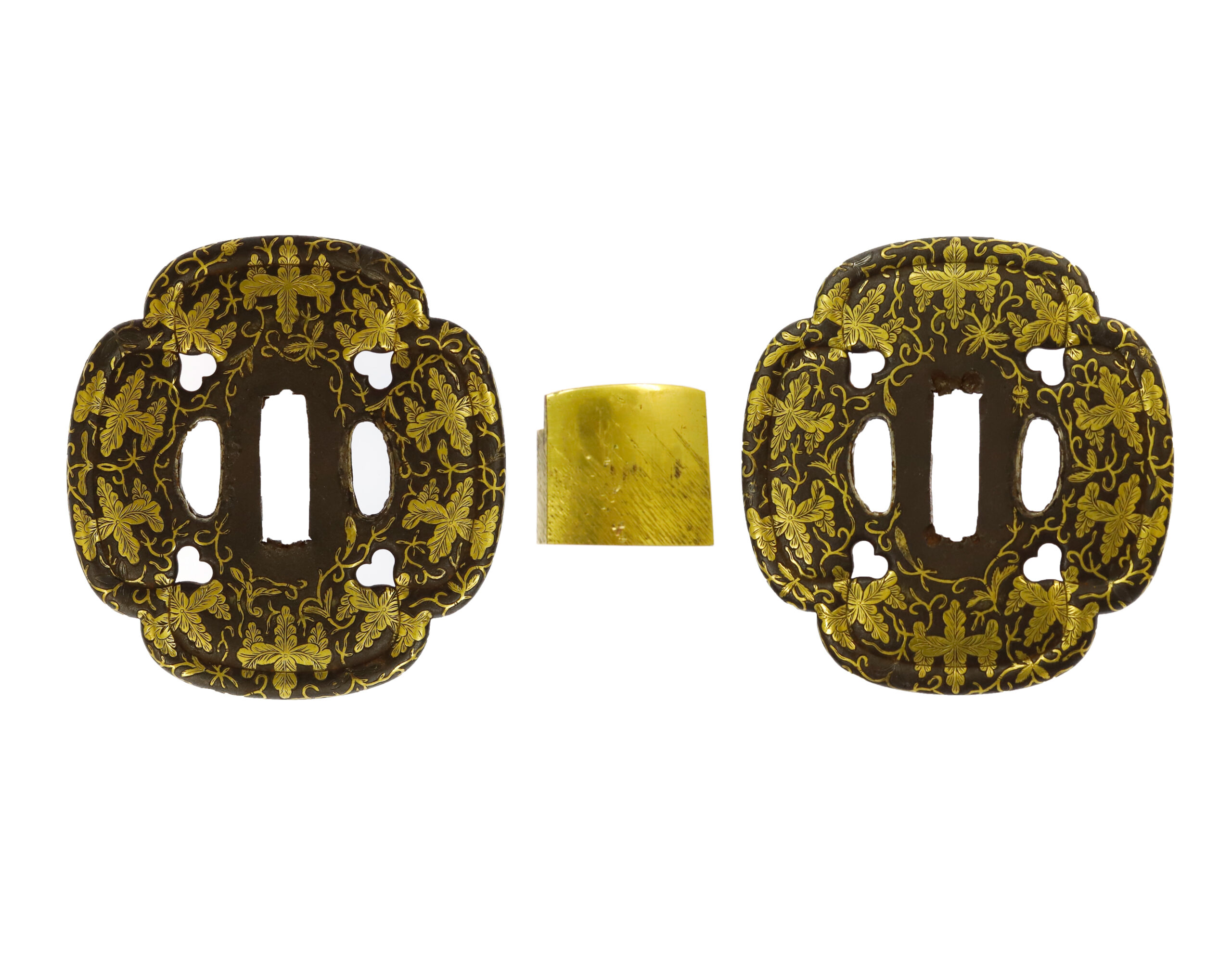
Saya: Saya is the scabbard for the Japanese sword.
This scabbard is decorated with the same motifs with the Kabutogane and Fuchi Kanamono. You would find the Maru-ni Ken Katabami-designed family crests and the Karakusa pattern. These patterns are colored in gold, adding an elegant flair to the scabbard.

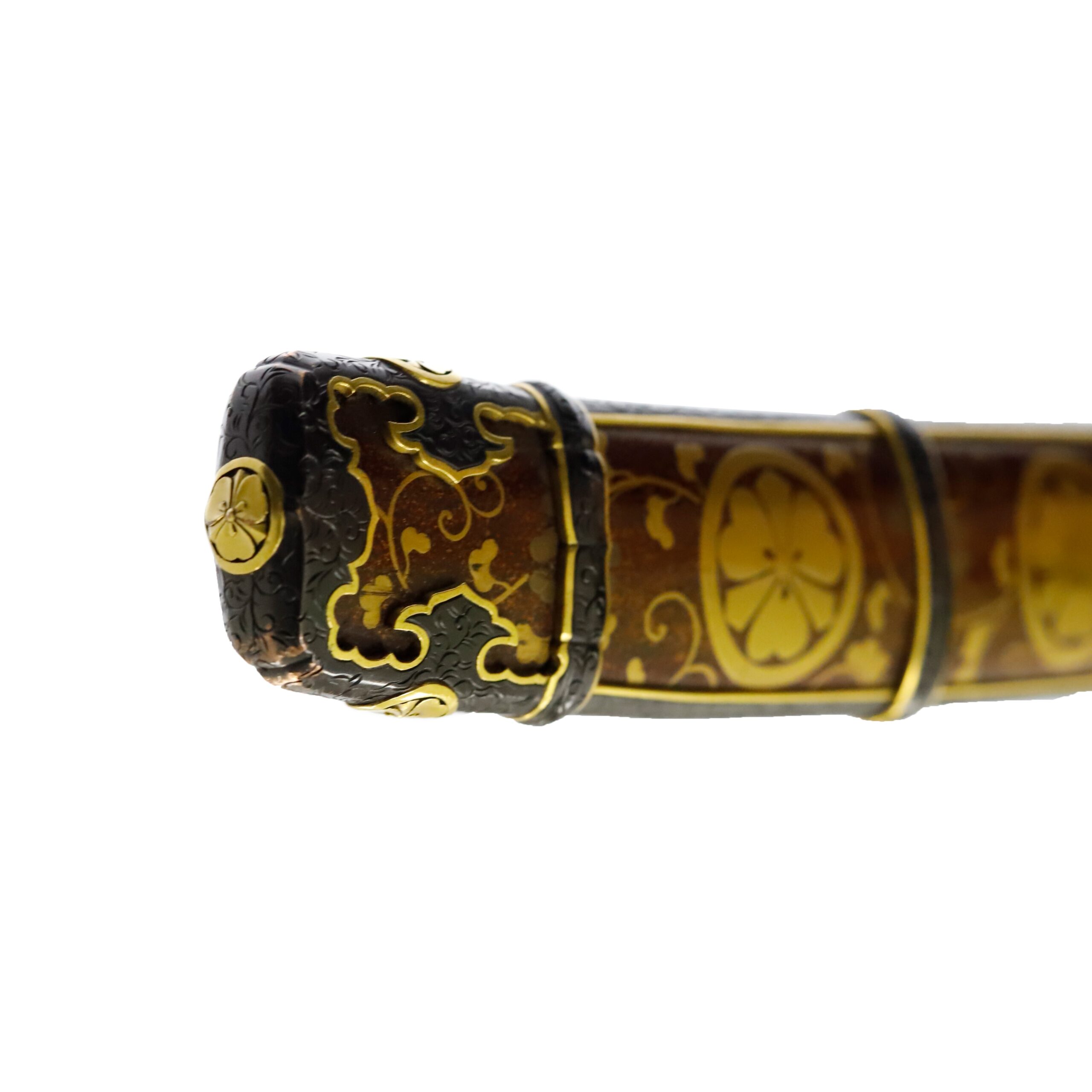
Authentication Paper:NBTHK TOKUBETSU Hozon Certificate for the blade
NBTHK, also known as Nihon Bijutsu Touken Hozon Kyokai (the Society for the Preservation of the Japan Art Sword), is one of the oldest Japanese sword appraising organizations in modern-day Japan. They authenticated the blade in December in the 4th year of Reiwa (2022). They appraised it as Tokubetsu Hozon Touken, the blade especially worth preserving for Japanese society. We are expecting to receive its certificate by the end of May. The purchaser will receive this original certificate as well. We can also translate what is written into English and make a PDF file for your record if you request.
Registration Number : Tokyo 324771
The Board of Education in Tokyo prefecture issued a registration paper for this sword . It is called Jyu Token Rui Torokusho(銃刀剣類登録証). Bunkacho(The Agency for Cultural Affairs) acknowledges a Japanese sword with this paper as a work of art.
The sword needs to be traditionally hand-forged and made of Tamahagane carbon steel to be registered in the system. With this paper, its owner in Japan can legally own an authentic Japanese sword. Based on this registration number, we will apply for its export permit.
This paper will need to be returned to the board of education when the sword is being shipped abroad, but you can receive a copy of it. An English translation of this registration paper is available on request.


—————————————————————–
【About us】
Samurai Museum is located in Tokyo, Japan, exhibiting antique artifacts related to the Samurai history. Samurai Museum Shop is the place for those who are interested in Japanese culture and craftsmanship. We deal with antique Samurai swords/armor, traditional crafts made in Japan and so on.
【Japanese Sword& Export Process】
The Japanese swords we deal with are hand-forged edged swords made in Japan. It was made from the traditional carbon steel called TAMAHAGANE(玉鋼). Samurai Museum is familiar with the proper legal procedure for an antique/ authentic Japanese sword to be exported from Japan. We have sent more than 500 Japanese swords for the past three years (~2023) to amazing owners who appreciate its historical value.
Each Japanese sword is registered under the Agency for Cultural Affairs and the Board of Education in Japan. They issue a registration paper for each Japanese sword for its owner in Japan to legally possess it. The Japanese sword with its registration paper means it was traditionally hand-forged in Japan.
To legally export the sword from Japan to other countries, we will have to apply for its permit to the Agency for Cultural Affairs(Bunkacho) and return the original registration paper to the Board of Education. It normally takes around 2-4 weeks to receive this permit after submitting required documents. And we would like you to expect at least 1-1.5 months for your order to arrive at your given address after you ordered. For more detailed info, please click here.
It is allowed for residents in Japan to own authentic Japanese swords without a special license as long as they come with registration papers. Please feel free to contact us if you are a resident of Japan, whether temporarily or permanently. We will also assist you when you leave Japan and need to obtain the export permit.
【Payment Method】
We accept payment through Stripe (Credit card), PayPal, Apple Pay or ChromePay, all of which are secure payment methods. Also, you don’t need to make an account on Stripe for the checkout. If you prefer other payment method, please contact us. After confirming your payment, we will apply for an export permit. You may either pay in JPY, USD, AUD, CAD,EUR CHF or GBP. The price is set in Japanese Yen. Prices in other currencies are automatically calculated based on the latest exchange rate.

* If the amount is above 1 million JPY, Stripe or wire transfer will be the only options for payment.
【Shipping】
We have shipped authentic Japanese swords to the USA, UK, Canada, Mexico, Germany, Switzerland, France, Hong Kong and Australia. If you don’t live in these countries and like to order, please contact us first before making a purchase. We offer Free International Shipping as long as we can send antique Japanese swords by EMS.
We normally ship by EMS(Express Mail Service) provided by Japan Post. We will send you a tracking number for your order as soon as we hand it to the post office. We will put 100 % insurance on the shipping document without any extra charge. Based on the total amount, there might be a duty tax or other fee for you to pay, depending on the countries. We use package cushioning to protect the item and put it in a PVC pipe, which is one of the most secure packages because of its durability.
It will normally takes 5-14 days for the item to arrive at your given address after we dispatch it. Time of delivery is estimated as accurately as possible by the carrier but does not take into account any delays beyond our control such as by inclement weather, post office holiday seasons.
* If you live in Australia and like to purchase an authentic Japanese sword, please click here to know the detail.
*Please keep in mind that due to the spread of COVID-19, there might be delays in shipping. If you like to know the detail about shipping, please feel free to ask us.

【Review】
Here is one of the reviews we received from a customer who purchased an authentic Japanese sword from us. For more reviews, please click here.
“My experience overall with the whole process was wonderful. I had many questions about the history and process to purchase these treasures. All my questions were answered very timely and complete. The staff is very knowledgeable and very well versed if any questions do arise.”
【How to make sure the condition】
Please keep in mind that what you are going to purchase is an antique item. We uploaded high resolution photos for you to check its condition thoroughly. If you like to see more photos with different angles, please feel free to contact us. We will be happy to send them to you so that you can make informed decision. It is essential for us to know that you are happy with your choice of a sword. and we are prepared to use the best of our ability to serve you.
【How To Contact Us】
Please contact us through email, Facebook Messenger or Live Chat if you have any questions. You can find each icon on the right side of the website. Please click one of them to reach us. We will reply to you within 1-2 business days.
【The Art of Nihonto (Japanese Sword)】
Samurai’s history is a profound, eloquent legacy of ancient Japanese warriors in which millions of people worldwide are being fascinated. If you like to find out the art of Nihonto, please click here.
【A Guide to Japanese Sword Maintenance】
After acquiring an genuine Japanese sword, it is also important to know how to take good care of it. Here is the special video for you. Mr. Paul Martin, Japanese sword expert, shows you how to give proper maintenance to your sword. By mastering how to clean the Japanese sword, its aesthetic beauty will last forever.
When you purchase a Japanese sword from us, you can get a Free Japanese sword maintenance kit. It comes with four tools(Choji Oil, Uchiko Whetstone Powder, Peg remover, Oil Applicator). By watching the video instruction above , you can enjoy learning how to maintain your Japanese sword while appreciating it. If you have any difficulty assembling the sword or cleaning the blade, you can feel free to contact us.


MORE ANTIQUE JAPANESE SWORD FOR SALE
SWORDS WITHOUT CERTIFICATES FOR SALE
LEARN JAPANESE SWORD TERMINOLOGY
Thank you for reading all the information on the page. If you have any difficulty choosing the right Japanese sword for you, we will be more than happy to help you find the one that speaks to you the most. Please feel free to contact us.
